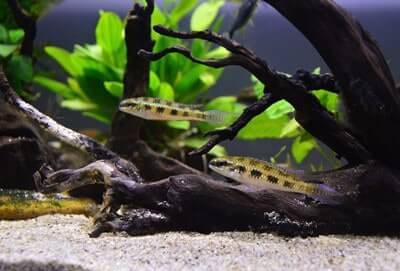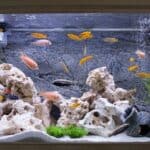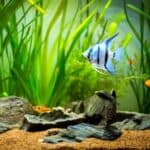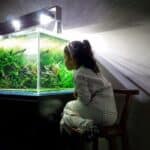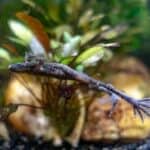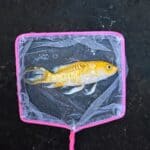Dwarf cichlids are much smaller than other fish and make an excellent addition to any community tank. They all look different, so we must know if dwarf cichlids are compatible.
South American cichlids have the same water requirements and can live in the same tank. They’re also relatively peaceful fish, so they shouldn’t cause each other harm.
Keep South American and West African dwarf cichlids separate, as they don’t get along well.
Apistogramma cichlids can only live together if the tank is large enough. Similarly, Agassiz’s cichlids bully Bolivian rams, so they’re incompatible.
How Big Are Dwarf Cichlids?
Dwarf cichlids are fish that are significantly smaller than other cichlid species. While there’s no official maximum size, cichlids smaller than 5 inches are considered “dwarfs.”
There are many dwarf species in the wild, but there are only a few that are commonly seen in aquariums.
South African dwarf cichlid species include:
- German blue ram cichlid, max size: 2 inches.
- Bolivian ram, max size: 3 inches.
- Panda dwarf cichlid, max size: 3 inches.
- Agassiz’s cichlid, max size: 3.5 inches.
- Black-stripe dwarf cichlid, max size: 3.5 inches.
- Cockatoo cichlid, max size: 4 inches.
There are fewer African dwarf cichlids, and they’re not as commonly found in fish tanks, but they include:
- False mpozo lionhead cichlid, max size: 2.5 inches.
- West African dwarf cichlid, max size: 2.5 inches.
- Blue-spotted goby, max size: 3 inches.
- Kribensis cichlid, max size: 4 inches.
- Lionhead cichlid, max size: 5 inches.
With most dwarf cichlids, the males and females are different sizes.
As described by the Environmental Biology of Fishes, females tend to be smaller, but there are instances when male dwarf cichlids don’t grow as big as females.
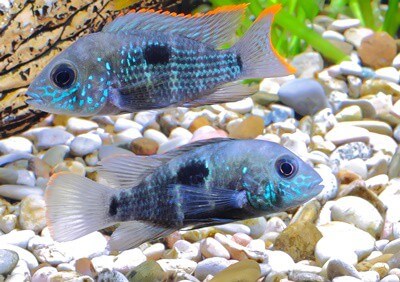
Dwarf Cichlid Tank Requirements
Dwarf cichlids are happy to live in a tank as small as 20 gallons. They don’t need too much room as they’re so little, but ultimately, the tank size you choose depends on how many fish you plan to keep.
There are three calculations you could use to determine your tank size:
- One inch per gallon rule.
- One inch per two gallons rule.
- Aquarium floor and surface area calculation.
You’ll also need to factor in any additional fish in your community tank besides dwarf cichlids. As described by Scientific Reports, fish are more aggressive when competing for food, territory, and dominance.
Because dwarf fish are part of the cichlid family, they can be aggressive and territorial.
To combat this, ensure the tank has plenty of plants and rocks that dwarf cichlids can hide amongst. They’re also a bit shy, which can help them feel protected.
Dwarf cichlids need relatively soft water to replicate their natural environment. However, they can tolerate medium to soft water.
The temperature should be between 72 and 86 degrees with a neutral pH of 6.5 to 8, or as close to this as possible. This makes them suitable to live with various tropical fish, not just other dwarf cichlids.
Can You Mix Dwarf Cichlids?
Even though dwarf cichlids come from different regions, they all fit into the tropical fish bracket. They can handle very similar conditions, meaning their water requirements are compatible.
However, you shouldn’t keep South American and South African dwarf cichlids in the same tank.
Both can be territorial, especially when breeding, and they’ll likely fight because of their different personalities. South American cichlids are more mild-mannered than their African cousins.
While you can mix cichlids of similar regions, you should only place one pair of each species in the tank.
Alternatively, opt for a ratio of one male to three females. Male cichlids don’t get on very well, regardless of their size and species, so having more females in the tank helps keep the aggression to a minimum.
Similarly, because they are cichlids, dwarf fish are naturally aggressive, even though they’re smaller than most other fish. This means you must choose tank mates wisely.
That said, dwarf cichlids tend to be less aggressive than their larger cousins, so you have some flexibility regarding your fish.
When mixing dwarf cichlids, they should be:
- A relatively similar size.
- Not too aggressive.
- Non-confrontational.
- Non-territorial.
Most dwarf cichlids are peaceful if they can maintain their territory. That’s why adding many plants and decorative features into the tank prevents fish from competing for dominance and helps them establish territories.
What Dwarf Cichlids Can Be Kept Together?
Almost all South American dwarf cichlids are compatible with each other, with some exceptions, which we’ve detailed below.
As described, their water requirements are similar, so most dwarf cichlids are suitable for beginners. As long as there’s not too much competition for territory and food, dwarf cichlids should live peacefully with one another without any significant problems.
Specifically, these are the compatibility requirements of the most popular South American dwarf cichlids:
German Blue Ram Cichlid
German blue ram cichlids are recommended because of their peaceful and gentle nature.
Their preferred tank mate is any member of the Apistogramma dwarf cichlid genus, as they’re fellow South American natives. They get on well outside of the breeding season.
Bolivian Ram
Bolivian rams are shy, so they prefer the company of peaceful dwarf cichlids because they’re not too aggressive. Because they’re so small and only reach 3 inches, they’re at risk of predation from larger fish.
Bolivian rams can also be kept alone, in pairs, or small groups.
Panda Dwarf Cichlid
The best dwarf fish for panda dwarf cichlids are ones that are of a similar size. This includes:
- Bolivian ram.
- Panda dwarf cichlid.
- Agassiz’s cichlid.
- Black-stripe dwarf cichlid.
However, they don’t do well with other Apistogramma cichlids in small tanks, so you must ensure enough space for all of them to live in.
You can house panda dwarf cichlids with other peaceful cichlids that aren’t too large, as long as there’s enough room in the tank to hide.
Agassiz’s Cichlid
The Agassiz’s cichlid is one of the most popularly kept Apistogramma cichlids.
They’re timid fish, so they prefer the company of quieter tank mates. One of the best dwarf species to pair them with is the German blue ram cichlid. However, they’re compatible with most other dwarf cichlids.
The only thing to watch out for is that Agassiz’s cichlids aren’t suitable for living with Bolivian rams, as Agassiz’s fish bully them.
Black-Stripe Dwarf Cichlid
The black-stripe dwarf cichlid is an easy-going fish that’s happy to live with other peaceful dwarf fish of the same size.
They can live alone or in pairs, but if you’re planning to keep multiple dwarf cichlids alongside them, they need a tank that’s at least 55 gallons.
Black-stripe dwarf cichlids prefer to swim close to the bottom of the tank, so fish that occupy the middle or top sections are best suited.
Cockatoo Cichlid
The cockatoo cichlid prefers to live in larger groups, so they’re incompatible with shy dwarf cichlids. With a maximum size of 3.5 inches, they should be housed with fish of a similar length.
In smaller tanks, you shouldn’t mix them, as they’ll become territorial. Larger tanks fare better with a few different types of Apistogramma.
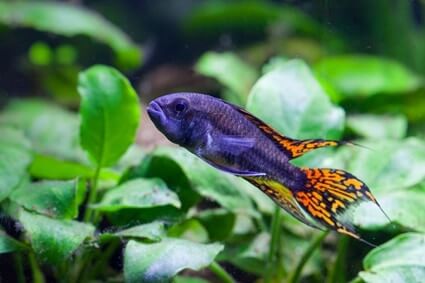
What Other Fish Can You Mix Dwarf Cichlids With?
You don’t only have to house dwarf cichlids with other dwarf species. There’s also a range of other fish that are just as compatible. This includes:
- Mollies.
- Hatchetfish.
- Swordtails.
- Platties.
- Semi or non-aggressive catfish.
- Small to medium-sized tetras.
Except for catfish, these fish are a similar size to dwarf cichlids and have mild-mannered personalities that allow them to live in harmony.
Angelfish and discus fish are happy to share their tank with dwarf cichlids.
That’s because they have peaceful personalities. However, don’t place dwarf fish smaller than two inches into the tank with your angelfish, as they’ll attempt to eat them.
While it may seem challenging to determine which dwarf cichlids are compatible, most South American species can live together. Choose fish of a similar size and monitor them to see how they interact.

